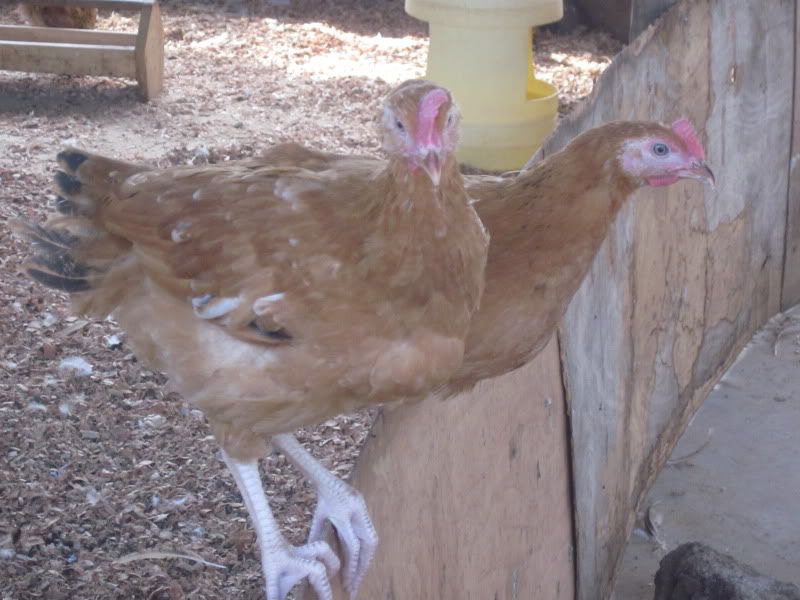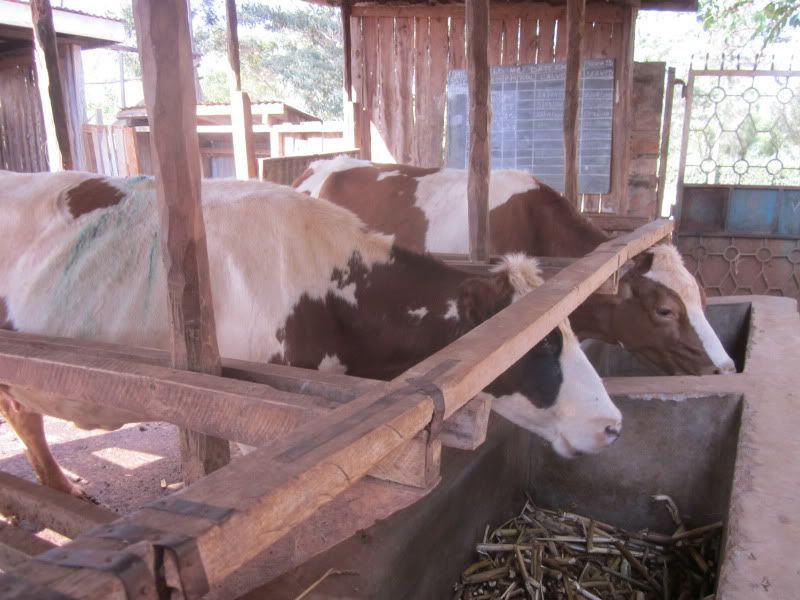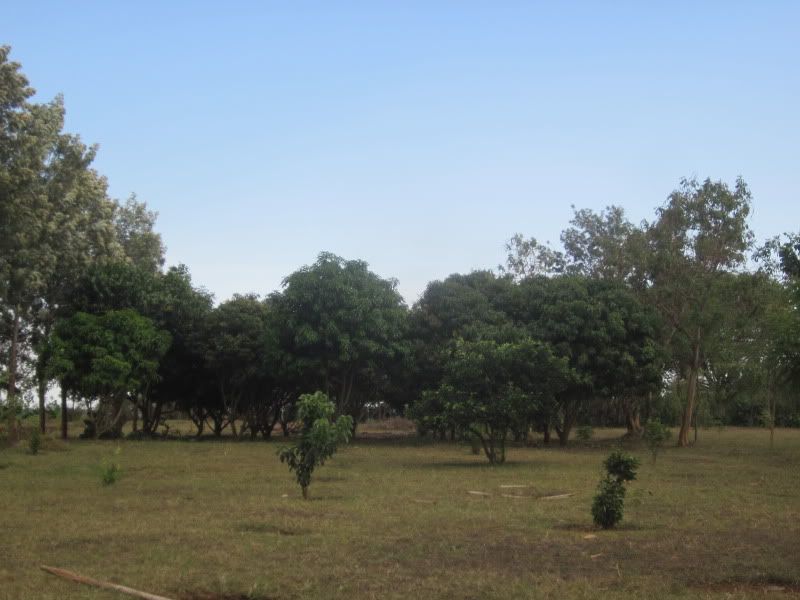As we drove there, Amy and I attracted lots of stares from all those we passed. What are those two wazungu [white people] doing in the back of a pickup??? We could see the signs of life changing in Bondo as we went - the brand new university, multistory buildings going up, and even street lights. Not to mention a nice new agrochemical store!

The new university in Bondo

The new tallest building in Bondo

Brand new street lights

Green World, a store selling agrochemicals from Bayer CropScience
Finally we arrived at Care for the Earth. At first glance I saw some well-manicured landscaping and modern looking buildings. We went into an office with a computer, and were guided into a second room with couches where they offered us sodas. Then we began a tour of the place.


Our guide first brought us to see the poultry - chickens, turkeys, and geese. He said, "Our vision here is basically as a learning resource center. Sometimes we keep birds which we'll use for catering purposes. We also have some which we breed and give to farmers." These animals are all what Kenyans call "grade" (pedigree breeds, not local varieties).
The first ones we looked at appeared to be Cornish crosses. They didn't even act like chickens. They just sat lazily around their enclosure. Our guide told us they were broilers, or "table birds" as he put it. "They are meant for meat. These ones are not laying eggs. We are just breeding them for our catering facilities." I asked him how long it takes to grow a broiler from birth to full-size. He said it takes a month and a half.

Broilers
Then he showed us a second variety called KenPro. These birds acted like chickens, at least. "KenPro is a hybrid and it is a duel purpose, for eggs and meat. And each batch of ten hens is served by one cock. So if there are twenty, two cocks." He said they start laying at four months. I asked how long it takes for the bird to grow big enough to eat. He said, "There is no need for eating it while it is laying." You wait until the bird stops laying after a few years and then eat it. "And it is big," he added. "Up to five kilos. The local ones, the maximum is two kilos. But these ones go up to four and five kilos... People in our society, they like bigger things."
He said that it's important to give these birds "concentrates" (purchased feed). "The local ons are free range and they go for caterpillars. But these ones, you are confining them. So you need to give them vitamins and minerals." He said this breed was introduced to Kenya by the government working together with the Netherlands.

KenPro chickens
He said they are getting one section ready for new 500 new broiler chicks as well as some new Ken Pro birds. They get the chickens from Kenchic.
Next, we saw the goats, which were in a nice, large yard.

The guide said, "Most of them are for milk. We use the hybrid buck to upgrade our local native goats so that we get the goats which produce milk." Goats are usually kept for meat here, and the local varieties are not great milkers. I think by hybrid he means a pedigree breed, not an actual hybrid.
"The goodness of a goat, any goat can eat anything. But mostly we do give them browses, all the leaves from the trees. They prefer the leaves of some trees and we know the types of trees which the goats eat. So we cut for them, we bring them here, they eat, sometimes they are allowed to go out grazing. A goat likes exercising, by maybe standing on two feet and getting browses up. You know, they like eating that manner."
"It is normal, one male goat should serve ten female goats. That is how it is required." He said we could buy the goats here. "A buck can go up to from 10,000 to 15,000. A female goes from 8,000 to 10,000." In dollars, the bucks are $120 to $180, and the females are $96 to $120.
I asked if the goats require purchased food too. He replied, "Sometimes we do give them salt, and we give them dairy meal also. They like it very much. But we don't normally give them the dairy meal all the time because the most preferred food for the goats are the browses."
Amy asked "Are they coping okay with this environment?" He replied, "Yes, because they prefer hot places." The breeds they keep are Toggenburg, Saanen, and German Alpine.
Next, we saw the cows. They are Ayreshires. He said they give 10-20 liters depending on the quality of feed. I don't know if that is per milking or per day. Either way, it's much more than the local breeds produce. "This one is the zero grazing unit. The animals can stay here in their lifetime, but we normally allow them to go do some grazing if there is some grass. But right now is dry." The manure is removed and fed to a biogas digester. They use the biogas for cooking in the kitchen.

Cows

Cows

Yard for the cows.
I would have loved to ask more about the cows, but our guide was very eager to show us the biogas digester, which he explained to us in detail.

Manure and water goes in here

Here is the biogas digster

The gas is piped to the kitchen.

The leftovers from biogas digestion come out here and they are used as fertilizer.
By then, Amy's young daughter and I spotted some papaya and mango trees. Our guide caught up with us and showed us the large passionfruit area that had papaya and Gravillea trees interspersed among the vines.

Passionfruit area in the distance, shaded under trees

I think the large trees in the distance are mango

An area that is plowed to grow maize once the rains begin. He said this was plowed manually, not with a tractor.

Passionfruit

An upside down bottle used to water the plants. They water once a day, but when it is very hot they water twice a day.

A woodlot that is also sometimes used for grazing the cows too.

Young plants growing under shade to protect them from the sun.

Tissue culture bananas

A native vegetable called mitoo (Crotalaria brevidens) that has gone to seed.
They are using this plant to collect seeds right now, but usually people eat the leaves. You can see more info about Crotalaria brevidens at the link.
Then we saw some other trees - mango I think. These are about 8 years old and our guide told us they are planted too close to one another.

Mango trees

Beehives. They have both Langstroth hives and Kenya Top Bar Hives. And these thorns will keep people away from the bees very effectively.
The last area we saw was where they do the catering and workshops. They have a nice training area, little cottages where guests can stay, areas where guests can have breakout sessions during workshops and trainings, and a kitchen. It seems that they make a lot of their money from holding trainings and catering for their trainees these days.

No comments:
Post a Comment